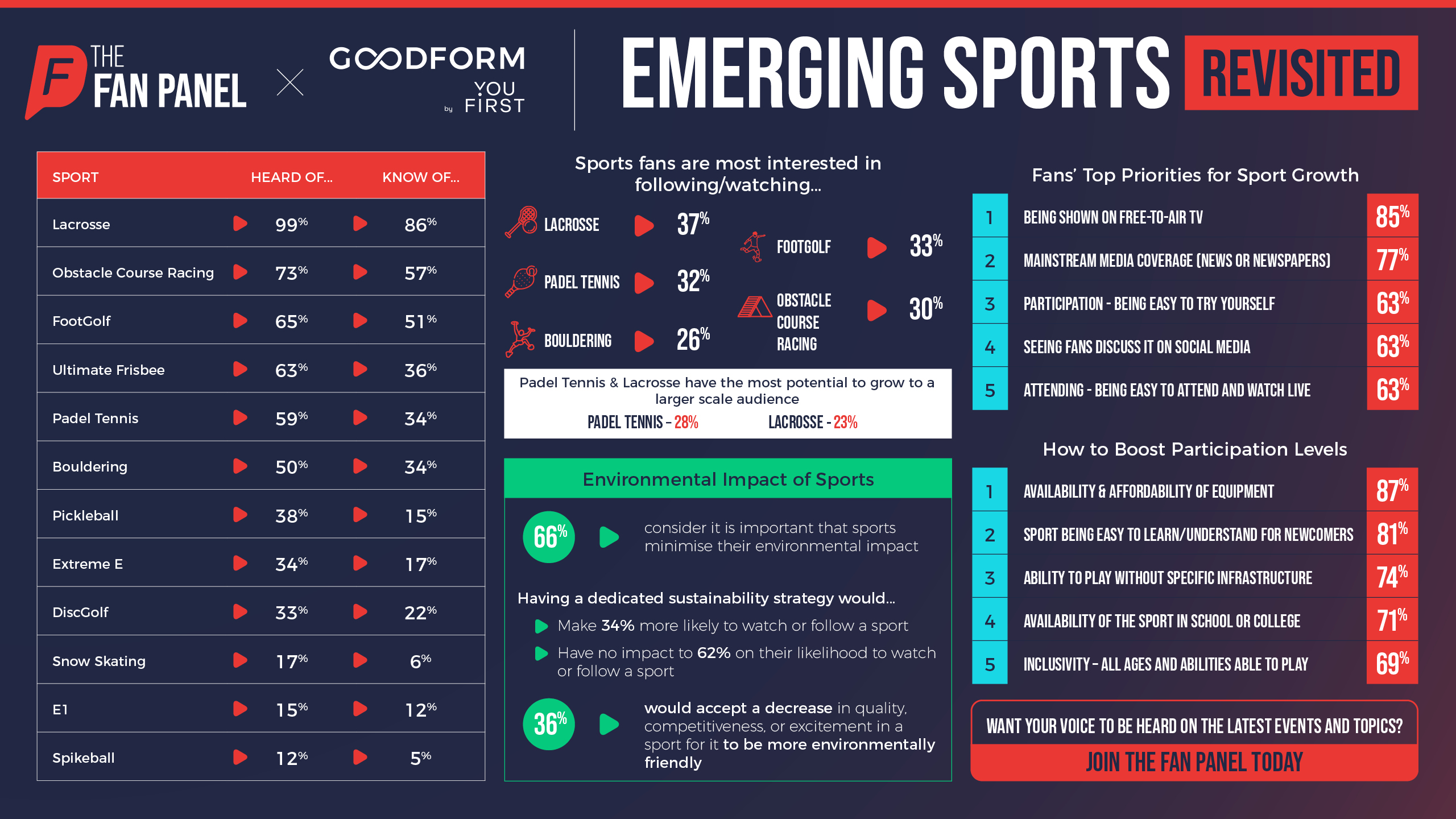The Fan Panel Delivers In-depth Fan Insights on Emerging Sports Trends
The engagement landscape of sports is in a perpetual state of evolution, with engagement and consumption trends constantly fluctuating, allowing for new and emerging sports to gain greater popularity in a much shorter time span.
With 2024 offering new opportunities for sports rightsholders to break into the market, Goodform asked fan panellists for their insights on a verity of emerging sports.
Goodform first explored the awareness levels of several emerging sports back in 2020, unveiling insights into their trajectories. Since then, certain sports have become household names while new sports have started to pick up traction.
These sports were selected to cover a range of different styles that are likely to appeal to different audiences.

Lacrosse Leads the way!
Lacrosse, now a household name, leads the pack with an impressive 99% recognition rate and an 87% rate of understanding among sports fans, solidifying its status beyond emerging. The international Olympic committee has clearly recognised the continuous demand for lacrosse, as the sport will make its long-awaited return to the 2028 Olympic games in Los Angeles.
Obstacle course racing, which featured in our original survey with a high recognition rate, has seen little to no change over the last three years. Meanwhile, bouldering and ultimate frisbee have continued to gain momentum, displaying a heightened relevance in the last 3 years.
Footgolf, a new edition to the line-up scores high with over half of fans understanding the concept of the sport.
The Rise of Racquet Sports
There is no denying that padel and pickleball have experienced unprecedented growth globally, with both sports seeing increased investment from shareholders and events rightsholders. Padel has seen unprecedented growth in Spain, Italy, and Sweden, while pickleball continues to expand in the United States.
59% of sports enthusiasts have heard of padel, while 39% know what the sport is. These metrics are only expected to grow as Playtomic’s global padel report predicts there to be 85,000 courts worldwide by 2026. However, it is worth highlighting that a majority of respondents reside in the UK, which has yet to become a top market for padel, as Playtomic defines the country to be in the ‘beginning stage’ of the sport’s growth development.
Pickleball however is only recognised by 38% of fans with only 15% of fans grasping its concept, suggesting that the sport is still a relatively new phenomenon outside of the United States.
2024 has already showcased plenty of padel action, as February saw the launch of the all-new Hexagon Cup in Madrid, featuring 6 teams of 6, divided into 3 pairs (male, female & Next Gen) all competing for a 1-million-euro prize fund. The first edition of the tournament saw Andy Murray’s Team AD/vantage emerge triumphant in both the male and female tournaments, with the men’s side defeating Rafael Nadal’s team in the final. RL9 were victorious in the Next Gen final, but what makes their victory intriguing however is their ownership, as RL9 is backed by Polish football legend, Robert Lewandowski!
Fan Favourites
Lacrosse triumphs again! with 37% showing an increased likelihood towards following the sport, with footgolf and padel backed by 33% and 32% of fans, respectively. When discussing overall potential, padel and lacrosse are clear winners.
28% of fans believe that padel has the potential to grow to a large-scale audience while 23% can see Lacrosse becoming a headline sport.
Strategies for Emerging Sports Growth
When exploring growth strategies, an overwhelming 85% majority of fans advocate free-to-air TV as the most effective medium, with a further 77% of fans considering mainstream media coverage to be a key driver in sport expansion. Other factors such as social media discussions, attendance levels, and being able to participate easily are also highly valued by panellists.
When participation is concerned, availability and affordability of equipment (87%) coupled with a sports adaptability to existing infrastructure (74%) act as key drivers for boosting participation rates.
Universal sports can be played anywhere, take football and cricket as examples. Many of the emerging sports listed above require little equipment, while the sports that do require specific infrastructure such footgolf, have utilised existing facilities from other historically established sports to ensure that they can fit into an already established sport landscape.
Ease of learning and accessibility across age groups emerge as pivotal factors for sport growth, as 81% emphasise simplicity for newcomers, and 69% prioritise inclusivity. Availability within schools, a crucial introduction point for athletes, resonates with 71% of respondents.
The Environmental Impact of Sports
While perceptions of emerging sports have fluctuated, views on environmental discussions in sports have remained consistent 3 years on.
As the spotlight on climate change & Net Zero intensifies, 66% of sports fans emphasise the need for sports to reduce their environmental footprint. Notably, 76% of women back this statement compared to 63% of men.
When discussing environmental policies, fans have made it clear that this should not come at the cost of competitiveness or excitement, as 64% of fans would not accept any decrease in overall quality. Furthermore, a 62% majority of fans admit that a dedicated sustainability strategy would not increase their likelihood of following a sport.
Fans are however more open to the option of paying a higher ticket price or subscription fee to support sustainable practices. 20% of fans would be willing pay more to support environmental causes, with an additional 39% considering the idea, provided costs remain affordable.


